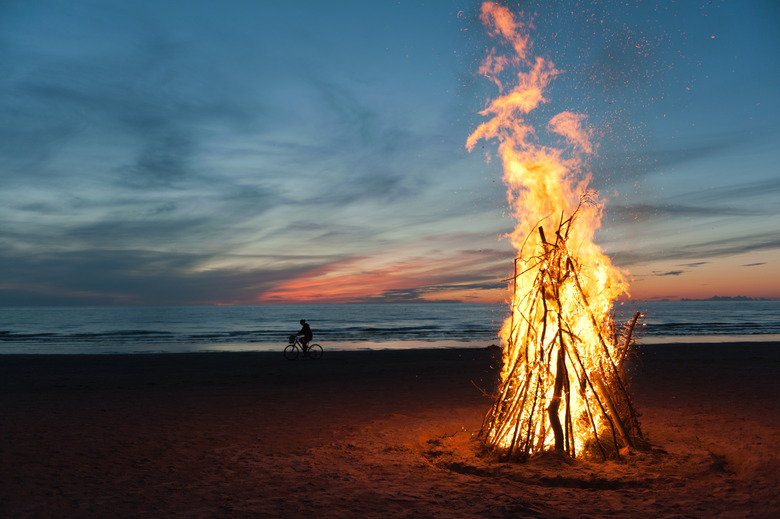How Hot Is A Bonfire?
A bonfire on the beach or at a campsite provides a cozy centerpiece and a source for roasting marshmallows. It's also an incredibly hot centerpiece that can quickly get out of control if not handled properly. A bonfire should be treated with respect as it can reach temperatures as hot as 1,100 degrees Celsius (2,012 degrees Fahrenheit). That is hot enough to easily melt aluminum.
TL;DR (Too Long; Didn't Read)
A bonfire can reach temperatures as hot as 1,100 degrees Celsius (2,012 degrees Fahrenheit), which is hot enough to melt some metals.
The Structure and Materials of the Bonfire Make a Difference
The Structure and Materials of the Bonfire Make a Difference
Oxygen, fuel and heat are the three things needed to build a bonfire. Fire is the resulting reaction of an interaction between wood and oxygen, producing heat. Wood needs about 16 percent oxygen to burn (air contains 21 percent), so a well-built bonfire will definitely get ultra-hot.
To make sure a bonfire lights easily and burns for more than a few minutes, the wood needs to be correctly piled. First place tinder (twigs, dry leaves); then sticks, preferably of around 1 inch (3 centimeters) round; and finally logs. The small pieces of wood burn more easily than logs because they reach high temperatures more quickly. These will help ignite the sticks, which in turn provide enough heat for the logs to go up in flames.
Bonfires should be made of dry wood – other materials, such as plastic, can pose a threat to the environment and may produce toxic gases that shouldn't be inhaled; live materials, such as sticks that are green in the middle, won't burn. Most types of wood will start combusting at about 300 degrees Celsius. The gases burn and increase the temperature of the wood to about 600 degrees Celsius (1,112 degrees Fahrenheit). When the wood has released all its gases, it leaves charcoal and ashes. Charcoal burns at temperatures exceeding 1,100 degrees Celsius (2,012 degrees Fahrenheit).
Why Does My Bonfire Look Like a Miniature Fireworks Display?
Why Does My Bonfire Look Like a Miniature Fireworks Display?
Combustion is a chemical reaction, and that's why fire is so colorful. Wood contains carbon atoms. When the wood combusts, the electrons in the carbon atom excite and move around. When they de-excite, they need to release energy, and that energy is released as the yellowish light that most bonfire flames have.
Wood also contains calcium and potassium, which can produce orange and lilac hues.
How to Extinguish a Bonfire?
How to Extinguish a Bonfire?
In 2016, humans caused 60,932 wildfires that burned about 4 million acres. To make sure bonfires don't become a wildfire, these fires need to be extinguished correctly. First allow the wood to burn to ash; then pour water on the ash and make sure all embers drown (when the ashes stop hissing, it's time to stop pouring water). If there's no water available, shovel dirt or sand to bury all embers and make sure the surface area is no longer hot before heading back home.
Cite This Article
MLA
Munoz, Gabriella. "How Hot Is A Bonfire?" sciencing.com, https://www.sciencing.com/hot-bonfire-8770/. 26 April 2018.
APA
Munoz, Gabriella. (2018, April 26). How Hot Is A Bonfire?. sciencing.com. Retrieved from https://www.sciencing.com/hot-bonfire-8770/
Chicago
Munoz, Gabriella. How Hot Is A Bonfire? last modified March 24, 2022. https://www.sciencing.com/hot-bonfire-8770/
